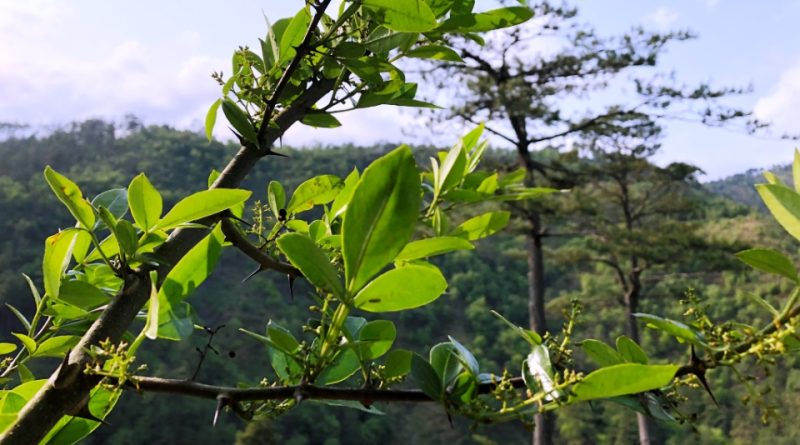Zanthoxylum acanthopodium
Zanthoxylum acanthopodium
Andaliman (Zanthoxylum acanthopodium DC.) Is an arboreal species belonging to the Rutaceae family.
Systematics –
From a systematic point of view it belongs to:
Eukaryota Domain,
Kingdom Plantae,
Magnoliophyta Division,
Magnoliopsida class,
Subclass Rosidae,
Sapindales Order,
Rutaceae family,
Subfamily Zanthoxyloideae,
Genus Zanthoxylum,
Species Z. acanthopodium.
The terms are synonymous:
– Aubertia timbor Buch.-Ham.;
– Aubertia timbor Buch.-Ham. ex Wall.;
– Fagara acanthopodium (DC.) Hiroë;
– Zanthoxylum acanthopodium var. acanthopodium;
– Zanthoxylum acanthopodium var. oligotrichum Z.M.Tan;
– Zanthoxylum acanthopodium var. timbor Buch.-Ham.;
– Zanthoxylum acanthopodium var. timbor Buch.-Ham. ex Hook.fil.;
– Zanthoxylum acanthopodium var. villosum C.C.Huang;
– Zanthoxylum alatum Wall.;
– Zanthoxylum timbor Wall..
Etymology –
The term Zanthoxylum comes from the Greek ξανθὸν ξύλον, which means yellow wood.
The specific epithet acanthopodium comes from the Greek ἄκανϑα ácantha, spine and from πóδιον pódion piedino, pedicello: with a thorny stem.
Geographic Distribution and Habitat –
Zanthoxylum acanthopodium is a plant native to East Asia. Its range includes southern western China (Guangxi, Guizhou, Sichuan, Tibet and Yunnan), Bangladesh, Bhutan, northern India and north-eastern India (Arunachal Pradesh, Assam, Manipur, Meghalaya, Mizoram, Nagaland, Sikkim, Uttar Pradesh and West Bengal), Nepal, Laos, Burma, Northern Thailand, Vietnam, Indonesia (Northern Sumatra Plateau), and Peninsular Malaysia.
Its habitat is those of open forests and woods, edges of the same, rocky and sloping places of the cliffs and mountains of the Himalayas at altitudes between 1,400 and 3,200 meters above sea level.
Description –
Zanthoxylum acanthopodium is a plant, which grows in the form of a tree or shrub, also climbing, thorny and evergreen, which can reach a height of 6 meters.
The trunk of older plants is covered with thorns that do not fall off but grow with the plant, becoming a showy feature.
The leaves are lanceolate ovoid, slightly hairy, composite and soft and of a bright green color.
The plant is dioecious, with male and female flowers and female plants can bear fruit without the need for the male.
The fruits are small, red in color and are found thickened on the branches of female plants.
Cultivation –
Zanthoxylum acanthopodium is a plant that is mainly harvested in its natural state, for its essential oil and medicinal use, although it is also sometimes cultivated.
It has thorny leaves and fruits with a strong lemon scent, so when used as a pepper substitute, like its close relative, Sichuan pepper, it gives a flavor that tastes more like lemon.
It is an excellent ornamental plant, especially for small private gardens, where on hot summer days it can be very appreciated for its lemon scent.
The plant propagates mainly by seed.
Customs and Traditions –
Zanthoxylum acanthopodium is a plant that like the closely related Sichuan pepper (Z. piperitum) its seeds are used as a spice in cooking and have the similar characteristic of numbing the tongue. However, in the kitchen, the flavor of andaliman has notes similar to lemon (similar to those of lemongrass) as well as a hint of the aromatic leaves of pandanus.
The seeds of this plant are dried, powdered and used as food flavorings and have a delicate and peppery flavor.
The plant is also used for medicinal purposes.
The seeds and the bark are used in the treatment of dyspepsia, fever, cholera, etc.
Among other uses, it should be remembered that the plant is used as an insecticide and an essential oil, called “wartara oil”, is extracted from its fruits by distillation; this is used in perfumery.
In addition, the wood, yellow in color, which is fine-grained, is used to make walking sticks, pestles, etc.
The plant, as mentioned, is also used as an ornamental especially in small gardens.
Preparation Method –
The seeds of Zanthoxylum acanthopodium are dried, powdered and used as food flavorings while an essential oil, called “wartara oil”, used in perfumery, is extracted from its fruits by distillation.
The plant is used as an insecticide species to remove phytophagous insects from crops.
Guido Bissanti
Sources
– Acta Plantarum – Flora of the Italian Regions.
– Wikipedia, the free encyclopedia.
– GBIF, the Global Biodiversity Information Facility.
– Useful Tropical Plants Database.
– Conti F., Abbate G., Alessandrini A., Blasi C. (ed.), 2005. An annotated checklist of the Italian vascular flora, Palombi Editore.
– Pignatti S., 1982. Flora of Italy, Edagricole, Bologna.
– Treben M., 2000. Health from the Lord’s Pharmacy, Advice and experiences with medicinal herbs, Ennsthaler Editore.
Photo source:
– https://inaturalist-open-data.s3.amazonaws.com/photos/67292109/original.jpg
– https://medialib.naturalis.nl/file/id/L.4194910/format/large
Warning: Pharmaceutical applications and alimurgical uses are indicated for informational purposes only, they do not represent in any way a medical prescription; therefore no responsibility is taken for their use for curative, aesthetic or food purposes.


